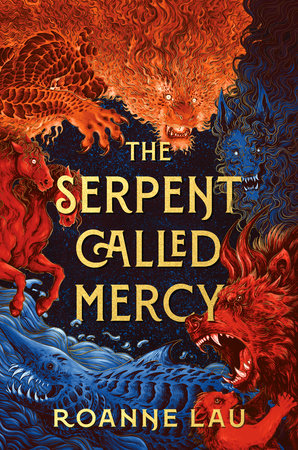A Q&A with Roanne Lau, author of THE SERPENT CALLED MERCY
Fighting to escape a life of debt and poverty by signing up as arena combatants who fight sun-cursed beasts in the seedy underworld of their city, lifelong friends Lythlet and Desil will soon discover that the most dangerous beasts are outside the ring. Learn more about Roanne Lau’s exhilarating fantasy debut, THE SERPENT CALLED MERCY in this Q&A with the author.
LAURA FITZGERALD: The Serpent Called Mercy’s worldbuilding is steeped in Southeast and East Asian references. Can you tell us more about the cultures you drew from and how they inspired your story?

ROANNE LAU: Absolutely—I’ve had a fairly nomadic life, and I’ve been lucky enough to live in Malaysia, Australia, Taiwan, and Japan. Paired with my Chinese heritage, these countries have greatly influenced my book in big and little ways. There are the broad strokes of Asian culture to be found in the interpersonal dynamics of my characters (how Lythlet interacts with her parents with the notion of filial piety weighing heavy on her mind, for example); the general deference expected to be shown towards those deemed superior in society; the strong intertwinement of religion and spirituality with everyday life and how that affects a character’s behavior.
And there are the smaller ways these cultures have manifested in my book: the architectural designs and food ingredients largely pull from what I see and enjoy in Malaysia, 4 being the number of death and 8 being a lucky number should be a familiar superstition to anyone acquainted with Chinese culture; even finer details like the gorgeous floral image that accompanies the prayers in the book imitating the sort of geometric floral art found in a lot of Malaysian designs reflect the deeply Asian spirit of THE SERPENT CALLED MERCY.
And as for the Australian part of me—well, the notion of the natural wildlife being dangerous as hell and out to kill you had to come from somewhere!
LF: How did you come up with the premise for this novel?
RL: Before I started writing this book, my head was brimming with three core desires all at once. I wanted to write a book about a deep but complicated friendship. I also wanted to write a character-driven book about how someone—an underdog in every way possible—could transform dramatically over the course of a year thanks to fame and success, and be forced to reckon with the conflict between her ambition and her morality. Lastly, I wanted to write a book that explored oppression and socioeconomic inequality, portraying the way injustice can permeate society and stifle one’s potential. And so THE SERPENT CALLED MERCY was birthed at the confluence of these various ideas, me fitting the various puzzle pieces together in one novel.
LF: The games that Lythlet and Desil enlist in are fascinating and terrifying. What made you choose the structure of twelve games, the arena, and the jackpot?
RL: I knew I wanted to show the progression of Lythlet’s character arc from ostracised, belittled slumdog to triumphant city-renowned conquessor over the course of a year. So it felt natural to create a bloodsport that’ll take place over a year on a monthly basis to show how her ascent into greatness transforms her persona gradually. I liked the idea of keeping the games to an arena, a closed environment where Lythlet and Desil would be forced to show both their individual characteristics and how they work together—all while vying for an incredible jackpot that’ll transform their lives, a prize that’ll make them question exactly how much they’re willing to sacrifice to win it.
LF: The way Lythlet defeats some of these beasts is like solving a puzzle. Without spoilers, can you share how you came up with some of these twists and turns?

RL: I’ve always been a fan of mystery novels growing up, with keen-eyed, quick-thinking characters like Sherlock Holmes, Nancy Drew, and Hercule Poirot keeping me entertained. So I approached most of my battles with the same sort of mindset, of wanting to see Lythlet not just engage in a straightforward punch-kick-dodge fight, but needing to harness her wits to deduce a beast’s secrets.
My process for creating a beast usually started with a quick image popping up in my head of what it looks like, one specific facet sticking out to me—for example, the anzura, the beast they fight in their second match, appeared before my eyes as a creature with two heads. And from there, I started asking myself, “Well, why does it have two heads? Are they identical to one another—nope, they’re different in some way. So how exactly are they different, why would they be different, and how can Lythlet use that knowledge to defeat it?”
LF: So few books focus on friendship, rather than romance or family bonds. What drew you to Lythlet and Desil’s relationship as a centrepiece for this novel? Did any of your own friendships inspire this dynamic?
RL: I’ve never seen friendship as a consolation prize, or a lesser-than genre of relationship between a woman and a man. Why should the absence of romantic attraction diminish the value of a meaningful connection? I think a solid friendship with the right person—someone who sees you for who you truly are and accepts you—can be just as transformative and beautiful, and I wanted to celebrate that. I’ve been lucky enough to have some lifelong friendships in my life, and I’ve personally experienced the ups and downs that comes with that, of growing alongside a person, as well as sometimes growing apart and only coming back together some time in the future. Fortunately, none of my friendships have been tested in a monster-fighting arena, though!

